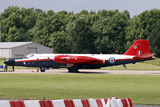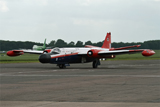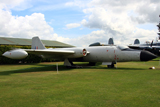English Electric Canberra

English Electric Canberra B.6 - WT333
The Canberra had its origins in a 1944 Air Ministry requirement for a successor to the de Havilland Mosquito, that is, a high altitude, high speed bomber with no defensive armament. Several British aircraft manufacturers submitted proposals. Among the companies short listed to proceed with development studies was English Electric, a well-established industrial manufacturer with very little aircraft experience.
The new English Electric design team was headed by former Westland chief designer W. E. W. Petter. The aircraft was named Canberra after the capital of Australia by Sir George Nelson, chairman of English Electric, as Australia was the first export customer for the aircraft. In May 1945 a contract was signed, but with the post-war military reductions, the prototype did not fly until May 1949. In the interim, the Air Ministry had already ordered 132 production aircraft in bomber, reconnaissance, and training variants. The prototype proved vice-free and required only a few modifications. A new glazed nose had to be fitted to accommodate a bomb aimer because the advanced H.2S bombing radar was not ready for production, the engines were upgraded to more powerful Avon R.A.3s, and the distinctive teardrop-shaped fuel tanks were fitted under the wingtips.
The resultant Canberra B.2 first flew on 21st April 1950, and entered service with RAF in May 1951. In a testament to the aircraft's benign handling characteristics, the transition program consisted of only 20 hours in the Gloster Meteor and three hours in the dual-control Canberra trainer. With a maximum speed of 470 kt (871 km/h), a standard service ceiling of 48,000 ft (14,600 m), and the ability to carry a 3.6 tonne payload, the Canberra was an instant success.
The Canberra is mostly a metal aircraft, only the forward portion of the fin being of wooden construction and covered with plywood. The fuselage is of semi-monocoque construction with a pressurized nose compartment. Each crew member has a Martin-Baker ejection seat except in the B(I).8 and its export versions where the navigator has to rely on a conventional escape hatch and parachute. The fuselage contains two bomb-bays with conventional clam-shell doors (a rotating door was implemented on the Martin-built B-57 Canberra). The wing is of single-spar construction, the spar passing through the fuselage. Outboard of the engine nacelles the wing has a leading-edge sweep of 4° and trailing-edge sweep of -14°. Controls are conventional with ailerons, four-section flaps, and airbrake's on top and bottom surfaces of the wings.
It was designed for a crew of two under a fighter-style canopy but delays in the development of the intended automatic radar bomb sight resulted in the addition of a bomb aimer's position in the nose. Wingspan and length were almost identical at just under 20 meters, maximum takeoff weight a little under 25 tonnes. Thrust was provided by a pair of 30 kN axial flow Rolls-Royce Avon turbojets.
In the United Kingdom, the demand for Canberra's exceeded English Electric's ability to supply airframes, and so Handley Page and Short Brothers manufactured them under licence. 901 Canberra's were manufactured in the UK, total worldwide Canberra production being 1352.



The Canberra B.2 started to enter service with No.101 Squadron in January 1951, with No.101 Squadron being fully equipped by May, and a further two squadrons, No.617 Squadron then No.9 Squadron being equipped by the end of the year. Production of the Canberra was accelerated as a result of the outbreak of the Korean War, with the type being designated as "super priority", allowing a further five squadrons to be re-equipped with the Canberra by the end of 1952.
The Canberra replaced Mosquito's, Lincoln's and Washington's as front line bombers, showing a drastically improved performance, proving to be effectively immune from interception during air defence exercises until the arrival of the Hawker Hunter.
An early use for the Canberra is the alleged 1953 spy flight that took place over the Soviet rocket launch and development site at Kapustin Yar, although the UK government has never admitted the existence of such a flight. Further reconnaissance flights are alleged to have taken place over, and along the borders-of, the Soviet Union in 1954 under the code name Project Robin, using the Canberra B.2. The sorties were no longer required after the introduction of the US Lockheed U-2 purpose-built spy plane in June 1956 and Project Robin was then terminated.
The Canberra played a part in many conflicts, being employed as a bomber by the RAF during the Suez Crisis, with around 100 aircraft involved, flying bombing and reconnaissance missions from both Malta and Cyprus. A total of 278 Canberra sorties were flown, dropping 1,439 1000lb bombs. While interception of the Canberra was within the capabilities of Egypt's MiG-15s and MiG-17s, as shown by the interception of Canberra's by MiG-15s prior to the Anglo/French invasion, although these did not result in any losses. The only Canberra shot down during the Suez campaign was a single PR.7 shot down by a Syrian Meteor on 6th November 1956, the last day of war.
Canberra's remained in front-line service with major air forces throughout the 1950s, 1960s, and 1970s, and continued to serve as bombers and reconnaissance aircraft with minor air forces through the 1980s and 1990s. In the UK, the PR.9 variant remained in service with No.39 (1 PRU) Squadron until July 2006 for strategic reconnaissance and photographic mapping, seeing service in the 2003 invasion of Iraq and, as recently as June 2006, in Afghanistan. The only Canberra's remaining in active service are two American-built B-57s operated by NASA for high altitude research.
In the Malayan Emergency, Canberra's were used by the UK, New Zealand and Australia. Ethiopian Canberra's were used against Eritrea and then Somalia during the 1970s, while both Rhodesia and South Africa used the Canberra in their respective Bush Wars. The Argentine Air Force received 10 B.62 and two T.64 trainers at the beginning of the 1970s. During the 1982 Falklands War, eight of them were deployed to Trelew, (a distance of 670 miles from the islands) to avoid congestion on the closer southern airfields. From 1st May to 14th June, they made 54 sorties, 36 of them bombing missions, of which 22 were at night against ground troops. Two aircraft were lost, one to a RN Sea Harrier using a AIM9L Sidewinder Air-to-air missile fired by Lt Curtis No.801 Naval Air Squadron on 1st May 1982, (Lt. Ibanez and Lt. Gonzalez ejected but were not rescued, while a second Canberra was damaged) and another, to a Sea Dart missile on 13th June fired by HMS Cardiff. The pilot, Capt. Pastran, ejected safely but Capt. Casado was killed. This was the last Argentine aircraft to be lost in combat during the Falklands War.
The RAF's three-seat trainer Canberra T.4s flew their last operational flights at RAF Marham in September 2005 because of the retirement of the photo-reconnaissance Canberra's on 23rd June 2006. In the twilight of their service these had been operational over Afghanistan.
| Model | Production |
|---|---|
| A.1 | 1 Prototype |
| B.1 | 4 preproduction prototypes |
| B.2 | 418 built (including 8 for export to Australia, United States and Venezuela) |
| B.5 | 1 built |
| B.6 | 106 built (including 12 for export) |
| B.6RC | 4 built |
| B(I).6 | 22 built |
| B(I).8 | 72 built (including 17 for export) |
| B(I).12 | 17 built (all exported to New Zealand and South Africa) |
| B.15 | 39 (all B.6 conversions) |
| B.16 | 19 (all B.15 conversions for the German Air Force) |
| B.20 | 48 built (all exported to the Australian Air Force) |
| PR.3 | 36 built |
| PR.7 | 71 built |
| PR.9 | 23 built |
| T.4 | 75 built (including 7 for export) |
| T.11 | 9 (all B.2 conversions) |
| T.13 | 1 built (exported to New Zealand) |
| T.17 | 24 (all B.2 conversions) |
| T.17A | - |
| TT.18 | 22 (B.2 conversions to target tugs) |
| T.19 | 1 (T.11 conversion to a silent target) |
| T.22 | 7 (all PR.7 conversions for the Royal Navy) |
| U.10 | Converted B.2 target drones |
| U.14 | Converted U.10 target drones |
| Short SC.9 | 1 (PR.9 conversion for radar missile development) |
| Length: | 65.49ft (19.96m) |
| Width: | 64.01ft (19.51m) |
| Height: | 15.65ft (4.77m) |
| Accommodation: | 3 |
| Hardpoints: | 2 |
| Empty Weight: | 21,649lbs (9,820kg) |
| MTOW: | 55,001lbs (24,948kg) |
| Max Speed: | 580mph (933kmh; 504kts) |
| Max Range: | 3,380miles (5,440km) |
| Rate-of-Climb: | 3,400ft/min (1,036m/min) |
| Service Ceiling: | 49,213ft (15,000m; 9.3miles) |
| Engine: | 2 x Rolls-Royce Avon RA.7 Mk 109 turbojet engines generating 7,400lbs each |
| Armament Standard: | None |
| Armament Optional: | 4 x 20mm Hispano Mk.V cannons OR 2 x 7.62mm machine gun pods 2 x 37x2 51mm rocket pods OR 2 x Matra 18xSNEB 68mm rocket pods Air-to-Surface missiles as needed Up to 8,000lbs of internal and external ordnance |
